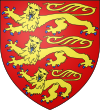Coat of arms of England
| |||||
The Royal Coat of Arms of England was the official coat of arms of the Monarchs of England, and were used as the official coat of arms of the Kingdom of England until the Union of the Crowns in 1603. Afterwards, the arms became an integral part of the Royal Coat of Arms of the United Kingdom. The spread of the British Empire has led to the arms being incorporated in various other coats of arms of the United Kingdom's former colonies.
History
Kingdom of England
Following the Norman conquest of England after 1066, the arms of the House of Normandy were used in England, two golden lions on a red field. The succession of King Henry II of the House of Plantagenet in 1158 saw the first known arms of an English monarch used, a golden lion on a red field.
When King Richard I ("The Lionheart") came to the throne he adopted his personal arms as three golden lions on a red field. The origin of these arms is thought to be based on the earlier Norman arms. According to one tradition, the extra lion was added to two existing Norman lions to represent the combined Anglo-Norman realm. According to another tradition the two leopards were combined with the single leopard of Aquitaine, as Henry II, the first Angevin king, had acquired the duchy of Acquitaine by marriage before inheriting the throne of England. Other heraldic authorities have claimed that at an early stage in the development of heraldry the number of Norman lions was not fixed and that it is simply a matter of design as to why England has ended up with three heraldic lions and Normandy with two.
In 1340, King Edward III laid claim to the throne of France and quartered the English arms with those of France, the "France Ancient", a blue shield with a tight pattern of small golden fleurs-de-lis of the French royal house.
In 1406, the French quarterings were updated to the modern French arms, three fleurs-de-lis on a blue field.
æ e best
Union of Crowns
On the death of Queen Elizabeth I in 1603, King James VI of Scotland inherited the English throne, becoming King James I of England. The arms of England were quartered with those of Scotland. A quarter for the Kingdom of Ireland was also added, as the English monarch was also King of Ireland.
The French arms were dropped from the Royal Arms of the United Kingdom in 1801 when King George III renounced the claim to the French throne. From that point, the heraldic representation of England reverted to the version used between 1198 and 1340, three golden lions on a red field.
Current use
The arms of England are not used in any official capacity on their own, although they do feature in the first and fourth quarters of the Royal Coat of Arms of the United Kingdom and the first Quarter of the Royal Coat of Arms of Canada. However, the arms of both the Football Association and the England and Wales Cricket Board are based on the three lions design. In recent years, it has been common to see banners of the arms flown at English football matches, in the same way the Lion Rampant is flown in Scotland.
In 1996, Three Lions was the unofficial song of the England football team for the 1996 European Football Championship, which was held in England.
Use in other arms

The spread of the British Empire has led to incorporation of the Royal Arms of England, or elements thereof, in the coats of arms of many other countries and territories.
Canada
- Coat of arms of Canada
- Coat of arms of Quebec
- Coat of arms of New Brunswick
- Coat of arms of Prince Edward Island
- Coat of arms of Saskatchewan
Commonwealth
Overseas Territories and Crown Dependencies
United Kingdom
- The arms of the Duchy of Lancaster is that of England with a label of three points each containing three fleurs-de-lis. This was the shield of Edmund Crouchback, 1st Earl of Lancaster (1245-96), the younger son of Henry III.
- The royal arms, as used between 1406 and 1603, appear as part of the arms of Westminster Abbey.
Lions or leopards?
French was the language of English government for a few centuries after the Norman Conquest of 1066, and in French blazon a lion, without further description, is always rampant; a lion passant guardant – one that is walking forward and facing outward toward the viewer – is always called a léopard. A lion rampant guardant is a léopard lionné, and one passant but with its head in profile is a lion léopardé. The terms describe the animal's posture, not his species. Whatever the beast is called, the heraldic lion or leopard should always have at least a hint of a mane.




